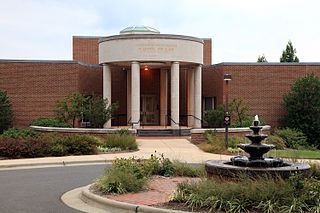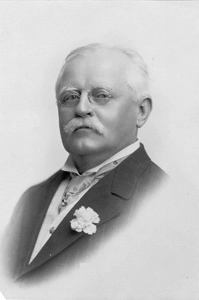
The University of North Carolina at Chapel Hill is a public research university in Chapel Hill, North Carolina. The flagship of the University of North Carolina system, it is considered a Public Ivy, or a public institution which offers an academic experience similar to that of an Ivy League university. After being chartered in 1789, the university first began enrolling students in 1795, making it one of the oldest public universities in the United States. Among the claimants, the University of North Carolina at Chapel Hill is the only one to have held classes and graduated students as a public university in the eighteenth century.

Greensboro College is a private college in Greensboro, North Carolina. It is affiliated with the United Methodist Church and was founded in 1838 by Rev. Peter Doub. The college enrolls about 1,000 students from 32 states, the District of Columbia, and 29 countries.

Frank Porter Graham was an American educator and political activist. A professor of history, he was elected President of the University of North Carolina at Chapel Hill in 1930, and he later became the first President of the consolidated University of North Carolina system.

Sandhills Community College is a public community college in Pinehurst, North Carolina. Sandhills was chartered in 1963, and officially opened October 1, 1965. It was the first comprehensive community college authorized and established as the result of legislation passed by the 1963 General Assembly of North Carolina. It is part of the 58-campus North Carolina Community College System. Sandhills Community College has approximately 4,000 students enrolled in college-credit curriculum courses and over 11,000 students who take continuing education courses annually.

The Dean E. Smith Student Activities Center is a multi-purpose arena in Chapel Hill, North Carolina, used primarily as the home for the University of North Carolina at Chapel Hill Tar Heels men's basketball team. The university began to inquire about building a standalone arena for the men's basketball team beginning in the mid-1970s, but due to an ongoing university wide investigation, the fundraiser halted until its conclusion. On June 1980, the fundraising began with a goal of at least $30 million and a target completion date for the building of December 1984. It was initially planned to be called the Student Activities Center; however, after its announcement it began to be referred to as The Dean Dome and it was speculated it would be named for then coach Dean Smith. The fundraising concluded in August 1984 with over $33 million raised, but construction would not be finished until 1986. The day before the opening game on January 18, 1986, against the Duke Blue Devils, the building was officially announced to be named the Dean E. Smith Student Activities Center, while a formal dedication happen later in September. In 2018, the hardwood floor of the Smith Center was named for then coach Roy Williams.

Oklahoma Baptist University (OBU) is a private Baptist university in Shawnee, Oklahoma. It was established in 1910 under the original name of The Baptist University of Oklahoma. OBU is owned and was founded by the Baptist General Convention of Oklahoma.

Woody Lombardi Durham was an American play-by-play radio announcer for the North Carolina Tar Heels football and men’s basketball programs from 1971 to 2011.

The University of North Carolina School of Law is a professional school within the University of North Carolina at Chapel Hill. Established in 1845, Carolina Law is among the oldest law schools in the United States and is the oldest law school in North Carolina.
PlayMakers Repertory Company is the professional theater company in residence at the University of North Carolina at Chapel Hill. PlayMakers Repertory Company is the successor of the Carolina Playmakers and is named after the Historic Playmakers Theatre. PlayMakers was founded in 1976 and is affiliated with the Dramatic and performing arts at the University of North Carolina at Chapel Hill. The company consists of residents, guest artists, professional staff and graduate students in the Department for Dramatic Arts at UNC and produces seasons of six main stage productions of contemporary and classical works that run from September to April. PlayMakers Repertory Company has a second stage series, PRC², that examines controversial social and political issues. The company has been acknowledged by the Drama League of New York and American Theatre magazine for being one of the top fifty regional theaters in the country. PlayMakers operates under agreements with the Actors' Equity Association, United Scenic Artists, and the Society of Stage Directors and Choreographers.

Julian Shakespeare Carr was an American industrialist, philanthropist, and white supremacist. He was married to Nannie Graham Parrish Carr, with whom he had two daughters and three sons.

Duke Energy Center for the Performing Arts is the main venue for the performing arts in Raleigh, North Carolina.

The University of North Carolina at Chapel Hill is a coeducational public research university located in Chapel Hill, North Carolina, United States. It is one of three schools to claim the title of the oldest public university in the United States. The first public institution of higher education in North Carolina, the school opened on February 12, 1795.

Bynum Hall is the current home of the University of North Carolina at Chapel Hill Graduate Admissions office and was the first home of North Carolina Tar Heels men's basketball team. At an executive meeting on October 2, 1903, it was revealed that school President Francis Preston Venable announced that former North Carolina Supreme Court justice William Preston Bynum donated $25,000 to have a gymnasium built in honor of his grandson who was a student at the university and had died due to typhoid fever. Architect Frank P. Milburn drafted plans for the structure, which were then approved by Bynum and the university's Board of Trustees. The building was designed to have a Greek architecture influence and had three stories with an above-ground basement. It originally contained a swimming pool, gymnasium. office spaces, and other rooms for various sports like boxing and fencing. Construction was expected to begin in mid-May, but construction was delayed because the company supplying the bricks were not organized. The building had started construction by June and had various target dates that were pushed back for undisclosed reasons and eventually the building was completed in February 1905.
John Sprunt Hill was a North Carolina lawyer, banker and philanthropist who played a fundamental role in the civic and social development of Durham, North Carolina, the expansion of the University of North Carolina at Chapel Hill and the development of rural credit unions in North Carolina during the first half of the 20th century.

The Unsung Founders Memorial at the University of North Carolina at Chapel Hill is a memorial located in McCorkle Place, one of the University's quads. It consists of a black granite tabletop supported by 300 bronze figurines and surrounded by 5 black stone seats. The inscription around the edge of the table reads:
The Class Of 2002 Honors The University's Unsung Founders – The People Of Color, Bond And Free – Who Helped Build The Carolina That We Cherish Today.

The Louis Round Wilson Library is a library at the University of North Carolina at Chapel Hill. Completed in 1929, it served as the university's main library until 1984. Today, it houses several special collections. The dome rises 85 feet over the university's South Quadrangle.

The North Carolina Collection is the largest collection of traditional library materials documenting a single state. It is part of the Louis Round Wilson Special Collections Library at the University of North Carolina at Chapel Hill. The origins of the collection began in 1844 with the creation of the North Carolina Historical Society. The collection formally came into existence after a donation from John Sprunt Hill in 1930 totaling $25,000. The collection includes The Thomas Wolfe Collection and The Sir Walter Raleigh Collection.
Maurice J Koury (1929-2016) was an American textile businessman and philanthropist who founded Carolina Hosiery Mills inc along with his brother Ernest Koury. Carolina Hosiery is the largest manufacture of socks in the US.
Sarah Graham Kenan was an American heiress and philanthropist. She inherited a third of her sister's share of the Standard Oil fortune in 1917 and established the Sarah Graham Kenan Foundation. Through her foundation, Kenan contributed financially to various institutions including the Episcopal Diocese of East Carolina, the University of North Carolina, Duke University, Saint Mary's School, and the Duplin County Board of Education. Her home, located in the Market Street Mansion District in Wilmington, North Carolina, now serves as the official residence of the chancellor of the University of North Carolina at Wilmington. In 1930, through an endowment she made, the Southern Historical Collection was established at the University of North Carolina at Chapel Hill.
















